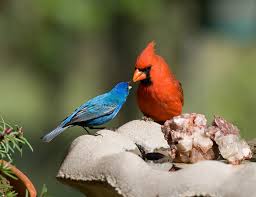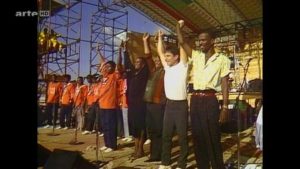Out of the Pure Blue
by Randall Auxier
 Every time I go to central Texas I am amazed by how ugly and hateful the grackals are. But this bird shimmers and shines iridescently and is often the color of deep indigo, which many regard as the most beautiful blue there is. Something has gone awry with the Divine creation here (although evolution seems quite serviceable in this case). This thing has googly yellow eyes. It makes loud sounds, and unnatural, like a buzz saw or someone tuning an old radio. Seagulls are plenty annoying, but if Hitchcock really wanted to scare people, he should have set his movie in Texas, in the H-E-B parking lot.
Every time I go to central Texas I am amazed by how ugly and hateful the grackals are. But this bird shimmers and shines iridescently and is often the color of deep indigo, which many regard as the most beautiful blue there is. Something has gone awry with the Divine creation here (although evolution seems quite serviceable in this case). This thing has googly yellow eyes. It makes loud sounds, and unnatural, like a buzz saw or someone tuning an old radio. Seagulls are plenty annoying, but if Hitchcock really wanted to scare people, he should have set his movie in Texas, in the H-E-B parking lot.
But compare the one iridescent bird to another. Above is the elusive indigo bunting, negotiating with a cardinal. I am told they sometimes cooperate to hold off the kestrels. Now a cardinal is a small bird, but as you can see, this fellow is twice the size of his neighbor in the bush. People say various colors are “happy” (yellow) or “cool” (blue and green) or “hot,” (red), but there is so much more than that to say. It seems like a disservice to our experience to put a color in a pigeonhole (since we are speaking of iridescent unrepentant birds). Crispin Sartwell writes: “Yesterday I saw my Indigo Bunting playing or battling with a cardinal across my yard, in an astounding and continuously transforming juxtaposition of color, and I wasn’t thinking of hot and cold or happy and sad or Mahler: I was completely absorbed in the scene, working just to keep track, with no time for or inclination to interpretation. It was a call to the present moment.” (Six Names of Beauty, p. 33)
That “call” to be in the moment is something we all know. It has to do with the fleeting moment and the impending sense of loss while every nerve in our bodies is absorbed in what cannot last. Sartwell says:
I have no evidence . . . but it seems to me likely that the human aesthetic sense arose not, for example, from some awesome majesty of a forest, mountain, sunset, but by the sudden burst or blossom of energized color across a field of vision: the flower, the fruit, the butterfly, the bird . . . beauty arises first in what stands out from the environment because of its unusual shape, bright coloration: the arousal of the senses. Too, the sense of beauty must be associated with loss, and the temporal boundedness of the flower, butterfly, bird are proverbial. (p. 28)
The Hebrew word for this is “יָפַע” which is transliterated as “yapha.” In Deuteronomy 33:2, in Moses’ last words before his death, he says: “God came from Sinai, shone forth (yapha) to them from Seir, and made an appearance from Mount Paran. From the holy myriads, He brought the fire of a religion to them from His right hand.” (Living Torah translation). In its own way, this is Sartwell’s shining, burst of color. Surely the visible spectrum and all of its glow was in the command “Let there be light,” but our ability to notice such things is limited by both time and place, and by what we are. But when a color calls to you, it is the fire of a religion.
Every artist and every performer understands. A burst, a shine, and an energy, in their fleetingness, can be captured in many ways. I am reminded of Paul Simon’s famous Graceland concert in Harare, Zimbabwe, in 1987. There were a million aesthetic decisions to be made. Simon was under tremendous pressure for violating a UN sanction held to be sacrosanct by the cultural forces of that time. One must isolate South Africa in every way to end apartheid, they believed. Simon was taking upon himself a unilateral, unearned moral authority for the sake of having a collection of pop music that would revive his career. He was not political; just looking for a new sound. Everyone knew it.
There were incidents and accidents and hints and allegations, but gradually the Graceland project took on a social importance no one foresaw. It was an opportunity. By the time the concert in Zimbabwe happened, Simon had a pretty clear idea of what he had done, largely unintentionally. He decided that something was going to flit across our field of vision with a burst of sound and color, and IT WOULDN’T BE HIM. If you watch the film, especially the opening of the concert, “Township Jive,” you cannot help noticing that all the color belongs to the other performers. Simon wore a pair of black jeans and a plain white t-shirt. He stood front and center, more in the role of a presenter than to be admired. The plain white shirt says, “you fill in what my role is here.” If he had pranced out like Elton John, or even just put a slogan or image on that t-shirt, he would have missed the moment, the aesthetic demand that something true and good be done.
It is a dicey thing when the beautiful, especially what is yapha, bursting forth temporarily, leads the true and the good by the hand into the future. There is no way to insure its guidance is sound. The fire in its right hand burns as well as illuminates. Many people now see Simon’s bold decisions as the beginning of the end of apartheid. There was a call to the present moment. The momentum turned. Millions of people bought the record, millions all over the world watched the concert, and Miriam Makeba‘s role was especially important. She had been in exile for over a quarter century on that day in Zimbabwe. The climactic moment of the concert came when she sang “Soweto Blues.” That performance was deep indigo, if you know what I mean, but it was followed with this amazing statement of solidarity when she sang (and translated, I think) “Under African Skies,” as a duet with Simon.
They sing “This is the story of how we begin to remember . . . these are the roots of rhythm and the roots of rhythm remain.” It is a song about Joseph, whose face is as black as the night, and Africa is his. This is not a threat, it’s a promise. The concert is in broad daylight so that everyone across the border can have no doubt that this diverse, celebrating crowd, bursting forth in fleeting color, is beautiful, and sooner or later, this is what South Africa will look like. The bonds will be broken. The world saw and finally understood. Pressure on the politicians from the dull, satisfied middle class grew. The politicians could act. I wouldn’t be surprised if the keepers of apartheid watched this and thought to themselves “we’re done for.” And they were, even though it took much more to make it happen.
Tony Hollingsworth and others recognized before Simon did that staging huge concerts could bring the plight of black South Africans increasingly into the light. There wasn’t sufficient support to do it until after Simon did his show. In 1988 they did a big show, and then in 1990, Miriam Makeba sang at the second, broadcast to over 60 countries. The regime decided to visit Nelson Mandella on Robin Island immediately after that concert. He was the only person who could lead the transition without a horrendous war. And that war was coming.
I believe that the tone of beauty, of bursting forth, was set by Paul Simon. In the midst of a sensory feast, as the humble presenter, he made a difference in how it all happened. He was saying: “Don’t you see how beautiful this is? Don’t destroy this beauty with violence. Work with it, follow the lead of your senses and your heart, and truth and goodness can also be yours.” I believe Paul Simon knew that this was his message. South Africa looks today as Zimbabwe looked that golden afternoon. A moment in time? Yes. But the roots of rhythm remain and help us begin to remember.
I never saw an indigo bunting until I was almost 50. It was astonishing. Could that bird actually exist? Nothing in my history prepared me for this sudden renewal of “innocence” in my senses, as Sartwell describes such experiences. The older we get, the harder it is to recover the innocence we had as children, when the whole world was a colorful show. But then in moments like that, or like the Graceland concert, we begin to remember, we are absorbed, and we play and dance in our hearts like children, like the crowd in Zimbabwe that day. It is . . . and I want to shout it, to exclaim it . . . it is Yapha! from the pure blue.


